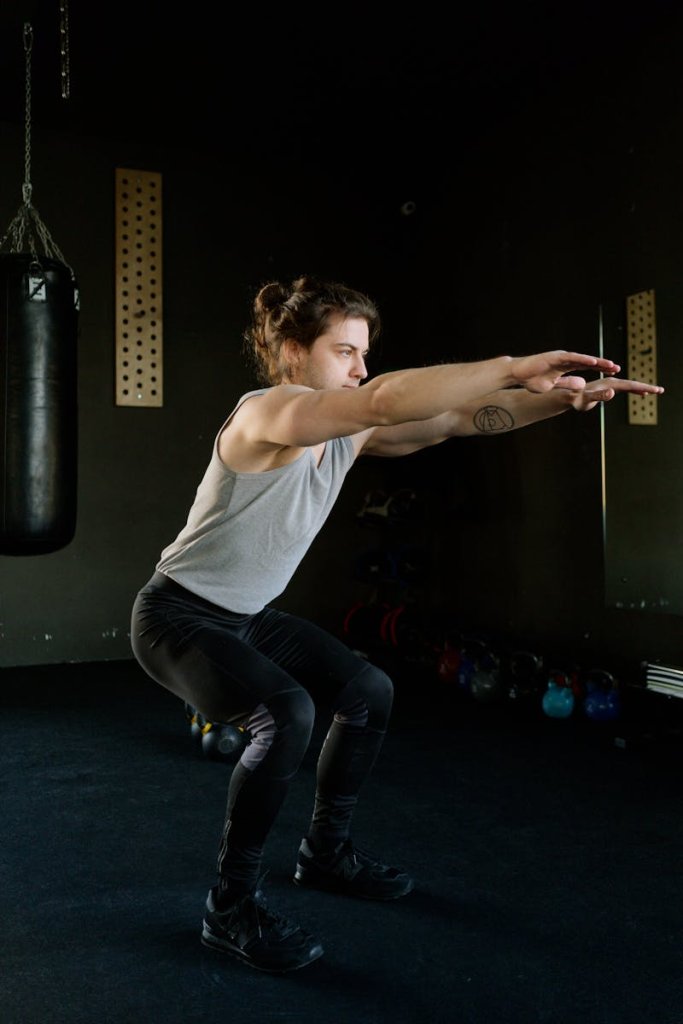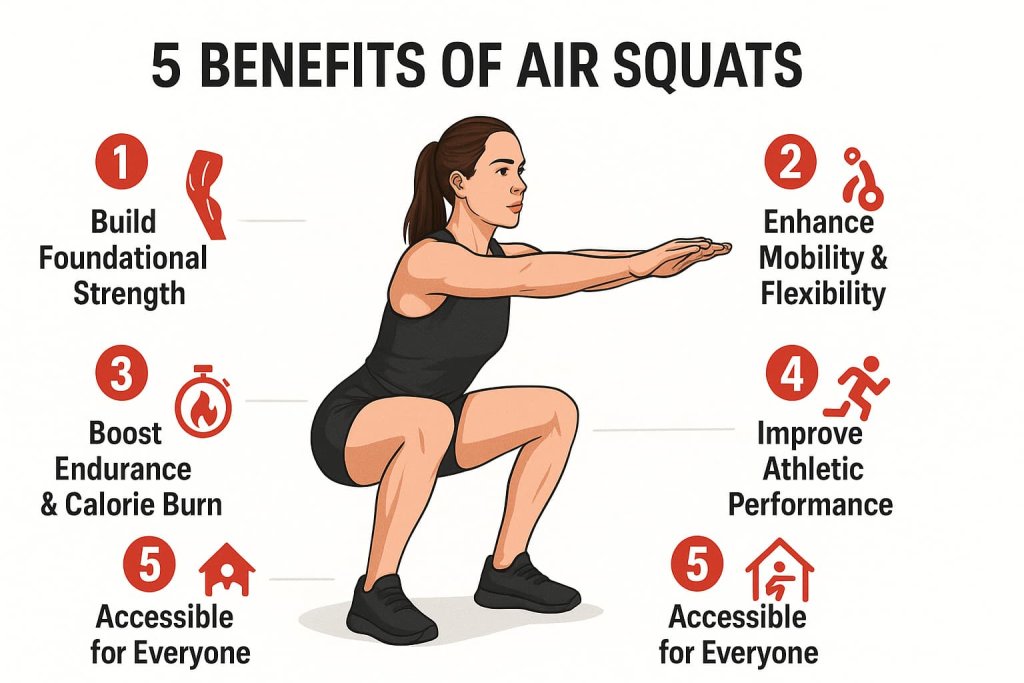Air squats are one of the most effective yet underrated exercises for building strength, mobility, and endurance — all without any equipment. They target your lower body and core while improving functional movement patterns that carry over to sports and daily life.

Many skip air squats in favor of weighted barbell variations, but that’s a mistake. Whether you’re a beginner learning the squat pattern or an advanced athlete refining form and endurance, air squats deliver results. This guide covers their benefits, proper form, variations, mistakes to avoid, and why they deserve a place in your workout plan.
What Are Air Squats?
Air squats are a bodyweight version of the squat where you lower your body until your hips are below your knees and then stand back up, engaging your leg and core muscles throughout.
- Primary Muscles Worked: Quadriceps, glutes, hamstrings
- Secondary Muscles: Core, lower back, calves
- Type: Functional, compound bodyweight movement
How to Do an Air Squat with Perfect Form
Follow these steps for optimal results:
- Start Position
- Stand with feet shoulder-width apart, toes slightly out.
- Engage your core and keep chest up.
- Descent
- Push hips back and bend knees, lowering until your thighs are parallel or hips drop below knees.
- Keep weight in heels.
- Ascent
- Drive through heels to return to standing.
- Squeeze glutes at the top.
- Breathing
- Inhale on the way down, exhale as you push up.
Trainer Tip: Keep your knees tracking over your toes to protect joints.
Common Mistakes to Avoid
- Rounding the Back – Maintain a neutral spine.
- Heels Lifting Off the Ground – Signals tight calves or poor weight distribution.
- Shallow Depth – Missing full range limits strength gains.
- Knees Caving In – Weak glutes or poor activation.
Benefits of Air Squats

1. Build Foundational Strength
Air squats strengthen the quadriceps, hamstrings, glutes, and core, providing a solid foundation for more advanced lifts like barbell back squats and deadlifts.
2. Enhance Mobility and Flexibility
By moving through a full range of motion, air squats improve ankle, knee, and hip mobility, which reduces stiffness and improves movement efficiency.
3. Boost Endurance and Calorie Burn
High-rep air squat workouts improve muscular endurance and elevate heart rate for better calorie expenditure, supporting fat loss.
4. Improve Athletic Performance
Air squats train explosiveness, balance, and coordination, essential for sports and dynamic movements.
5. Accessible for Everyone
No gym? No problem. Air squats can be done anywhere, anytime, making them one of the most versatile exercises available.
Popular Squat Variations
1. Jump Squats – Add Plyometric Power
Jump squats are a dynamic, explosive variation that builds both strength and power. By adding a jump at the top of the movement, you train your fast-twitch muscle fibers, improve vertical leap, and boost athletic performance.
How to Do It:
- Stand with feet shoulder-width apart.
- Perform a standard squat, lowering until thighs are parallel to the floor.
- Explosively push through your heels to jump as high as possible.
- Land softly with bent knees and immediately go into the next rep.
- Trainer Tip: Keep your core tight to prevent spinal compression on landing, and limit sets to 6–12 reps to avoid excessive fatigue.
Best For: Athletes, fat-burning circuits, and anyone looking to improve explosiveness.
2. Pistol Squats – Advanced Single-Leg Strength
Pistol squats are a challenging single-leg variation that improves balance, coordination, and unilateral leg strength. They also highlight any strength imbalances between legs.
How to Do It:
- Stand tall and extend one leg straight in front of you.
- Lower yourself slowly on the standing leg while keeping the other leg elevated.
- Descend until your hamstring is close to your calf, then press back up.
- Trainer Tip: Start by holding onto a support (like a TRX strap or pole) to assist balance. Over time, aim to perform it unassisted for maximum strength gains.
Best For: Advanced lifters and athletes who want superior leg strength and mobility.
3. Tempo Squats – Slow Down for More Time Under Tension
Tempo squats involve deliberately slowing down the lowering (eccentric) and/or rising (concentric) phase to increase time under tension, promoting hypertrophy and control.
How to Do It:
- Set a tempo like 3-1-2 (3 seconds down, 1-second pause at the bottom, 2 seconds up).
- Maintain perfect form and core engagement throughout.
- Use lighter weights than your normal squat to account for the increased difficulty.
- Trainer Tip: Keep your breathing steady—inhale during the descent, exhale on the way up.
Best For: Building muscle, improving squat technique, and developing stability.
4. Wide-Stance Squats – Target Inner Thighs and Adductors
By widening your stance beyond shoulder width, you shift more emphasis to the inner thighs, adductors, and glutes. This variation can also improve hip mobility over time.
How to Do It:
- Stand with feet 1.5–2 times shoulder-width apart, toes pointed slightly outward.
- Keep your chest up as you squat down, pushing knees out in line with your toes.
- Press through heels and squeeze glutes at the top.
- Trainer Tip: Avoid letting knees cave inward—actively push them out throughout the movement.
Best For: Lower-body shaping, hip mobility, and targeting underdeveloped inner thigh muscles.
Programming Air Squats
- Beginners: 3 sets of 12–15 reps, 2–3x per week
- Intermediate/Advanced: High-rep circuits, EMOM (every minute on the minute), or add resistance bands for extra challenge.
Why They’re Underrated
Despite their simplicity, air squats bridge the gap between mobility, strength, and endurance—qualities essential for long-term fitness and injury prevention. Neglecting them can lead to poor movement quality and weaker foundations, even if you lift heavy weights.
FAQs About Air Squats
1. Do air squats build muscle?
Yes, especially for beginners, though advanced lifters may need to add resistance for continued growth.
2. How many air squats should I do daily?
Start with 3 sets of 15–20 reps. Gradually increase reps or add variations.
3. Can air squats replace weighted squats?
They can maintain strength and mobility but won’t match the hypertrophy potential of heavy lifting.
4. Are air squats bad for knees?
Not if performed with proper form. In fact, they can improve knee health by strengthening surrounding muscles.
5. Can air squats help with weight loss?
Yes, when included in high-intensity circuits, they burn calories and increase metabolic rate.
6. What’s the best warm-up before air squats?
Hip openers, ankle mobility drills, and dynamic lunges.
Conclusion
Air squats may not look impressive, but they’re a strength, mobility, and endurance powerhouse that belongs in every training plan. Start incorporating them into your warm-ups, circuits, or active recovery days — your legs (and your future lifts) will thank you.
